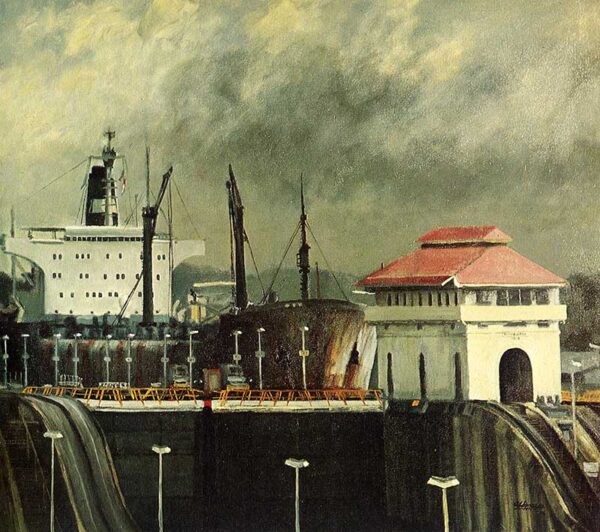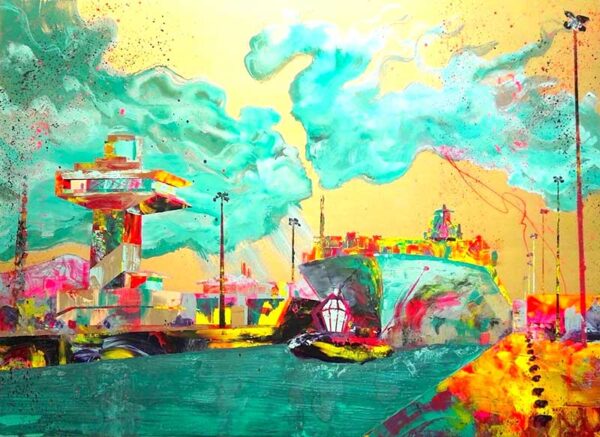The Panama Canal on canvas
The Panama Canal has been a source of inspiration since its construction. Many artists over the years have given color […]
The Panama Canal has been a source of inspiration since its construction. Many artists over the years have given color and life to the Canal in their works. Examples abound.
During the construction of the Interoceanic Canal in 1912, the Norwegian landscape painter Jonas Lie traveled to Panama from New York to paint a series of works that showed the extraordinary human effort that was being carried out.
Also, Joseph Pennell, one of the greatest American lithographers of the early 20th century, traveled to Panama in 1912 to recreate images of the Canal during its construction, the greatest engineering work of its time. He created 28 lithographs of impressive detail.

Living testimony in Panama
In the rotunda of the Administration building remain the murals of William Brantley Van Ingen, who captured the human epic of the union of the oceans through the Isthmus.
His murals have endured for more than 100 years. They were installed in 1915 and comprise an area of 1,000 square feet to illustrate different phases of the construction of the Canal.
Van Ingen painted the murals on separate panels in his New York studio, which were installed in January 1915 under the artist’s own supervision.
Born in Philadelphia and later settled in New York, Van Ingen received similar commissions for other murals at the Library of Congress in Washington and the U.S. Mint, among others.
For his murals, Van Ingen worked with two assistants: C.T. Beery and Ira Remsem, who left a series of charcoal drawings of the last stage of Canal construction. These paintings are the largest set of murals by an American artist on display outside the United States.
From Inspiration to Canvas
Van Ingen’s work inspired new generations.
Notable among this group are Al Sprague, George Scribner and Mathew Tomlet, whose works rest in various Panama Canal buildings. Tomlet grew up admiring Al Sprague’s work in the Administration Building.
“I always enjoyed walking in the rotunda and seeing his paintings. I don’t remember when I met him, he’s a great guy; he supported me and helped me a lot,” admits Tomlet, who in an interview with El Faro and Tu Canal al Día, had a chance to re-appreciate the paintings he did for the Panama Canal in the 1990s.
“There’s something powerful when you’re on the central wall of the lock; when you look at it up close it’s magic,” the U.S.-born painter stresses. Tomlet came to Panama in the early 1970s, when his father was hired as a Canal pilot.

There is a new generation of young people who, from their perspective, capture the essence of the Canal in their works. This is the case of Gabriel Wong, a 36-year-old architect and artist, who divides his time between his work as an architect and his passion for painting.
“I grew up seeing the historic charcoals, and the central dome in the Administration Building, which are historic and spectacular, but true to their time, so a lot of what I try to do is bring the Panama Canal and express it through my eyes here in the 21st century,” Wong says.
To delve deeper into his artistic process, Wong explains that he tries to represent the Canal “in a fresh way, so maybe that’s why I’ve done more works with reference to the Third Set of Locks. I believe that in art it is important to reinforce the message of where we come from, where we are and where we are going”.
The Canal from the inside
For those who are inside the Canal, it is a source of endless inspiration. Luis Adrián Valdespino is a visual artist and, in addition, a linehandler leader (interim) in the Panama Canal’s Launch and Linehandler Section.
“I was born among paintings, my father was a painter, he had a studio and he was my first school,” explains Valdespino, born in the capital. His father, a painter and sign maker, taught him the technique and the basics of art.
Today, every working day for Valdespino is an inspiring experience.
“As an artist I always live with inspiration. From the moment I am called to get on a ship, my vision focuses on my surroundings; sunsets and sunrises on Gatun Lake are an inspiration to me,” he admits.
After multiple artistic recognitions since his childhood and his participation in different exhibitions, he recognizes that what he is most requested today, after 25 years of working at the Canal, are drawings and caricatures to honor retiring colleagues.
The art of the Canal expansion
During the expansion program, the Canal administration called upon a group of Panamanian artists to share their artistic perspective of the expansion work. Idalia Espinosa, now a Resource Management Specialist in the Corporate Development Division, was in charge of the group.
As Espinosa recalls, this was an initiative that had the vision of documenting the expansion through painting and, in 2009, began with a multidisciplinary team and the commissioning of a series of artists.
“It began with artist George Scribner with five paintings in 2009,” Espinosa explains.
“Then we incorporated maestro Carlos González Palomino (r.i.p.), José Inocente Duarte, Roberto Vergara, Amalia Tapia, Pascual Rudas, Marta and Adriana Arango, and Jack Fallenbaum,” he added.
With this project, as the works were being developed, the museological function of compiling the collection and disseminating it to society was fulfilled.
Subsequently, two important exhibitions were held for the Centennial of the Canal at the Museum of Contemporary Art and, in 2017, for the commemoration of the 20th anniversary of the Interoceanic Canal Museum.
Another outstanding aspect of that project was the participation of a group of 66 collaborators of the Pacific locks, who, led by engineers Samuel Cohen and Oscar Páez, imprinted their vision of the expansion.
Espinosa explains that each collaborator “felt that they were going to leave a legacy for history by painting”. So they assembled a canvas and, guided by the engineers, painted one of the scenes of the construction of the Cocolí Locks.
For Espinosa, this was “an unforgettable experience, because as they painted the works, they told us how proud they were that the Canal was under Panamanian administration and that they could express their joy and pride in being Panamanians through their art”..
At the end of the Canal expansion program, these works were transferred to the Roberto F. Chiari Library, where they are in charge of preventive conservation and historical documentation. The works are located in iconic Canal sites such as the Administration Building, the 107th Official Residence, and the Ascanio Arosemena Training Center.